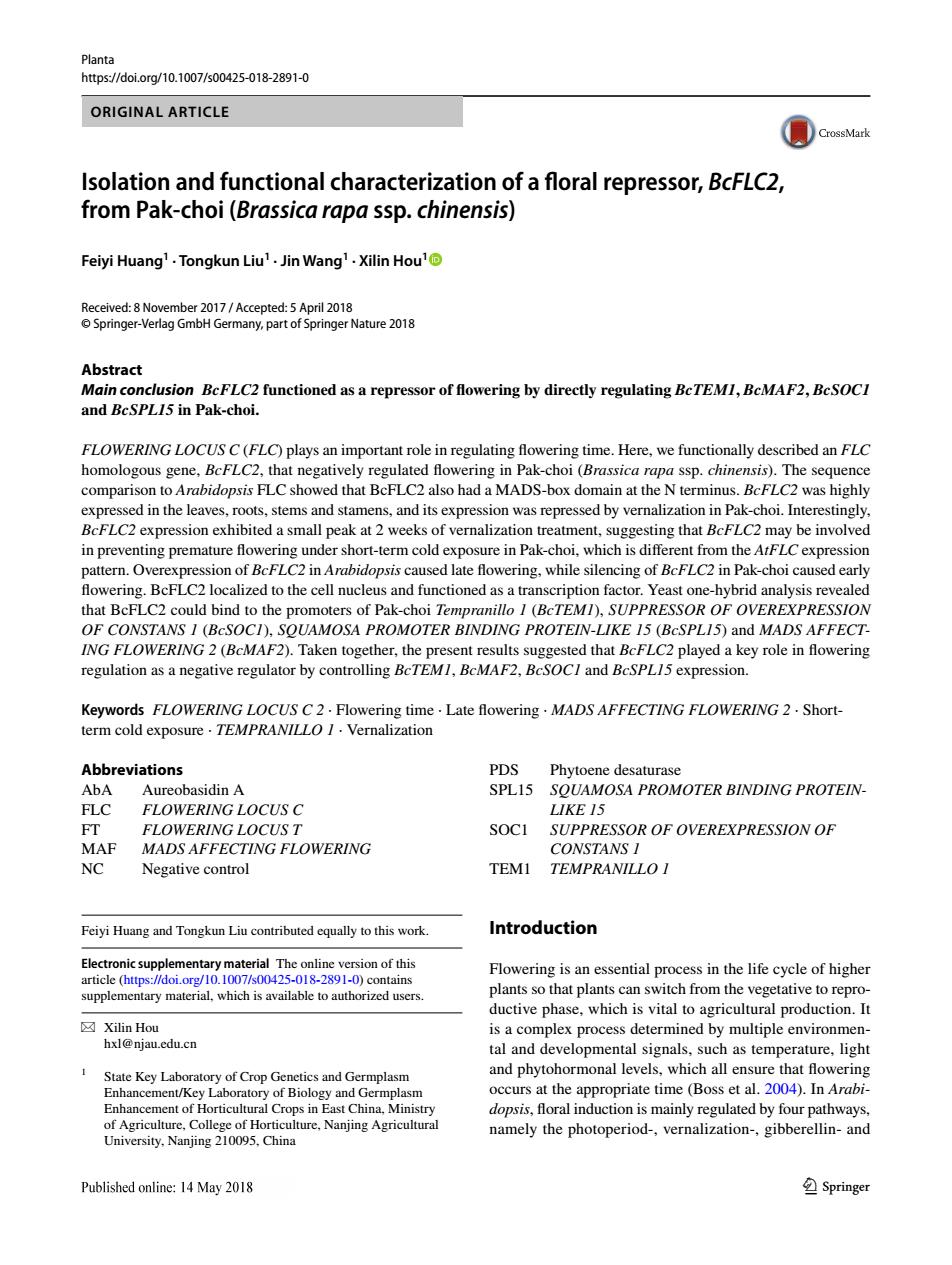正在加载图片...

Planta https:/doi.org/10.1007/s00425-018-2891-0 ORIGINAL ARTICLE CrossMark Isolation and functional characterization of a floral repressor,BcFLC2, from Pak-choi (Brassica rapa ssp.chinensis) Feiyi Huang'.Tongkun Liu1.Jin Wang'.Xilin Hou Received:8 November 2017/Accepted:5 April 2018 Springer-Verlag GmbH Germany,part of Springer Nature 2018 Abstract Main conclusion BcFLC2 functioned as a repressor of flowering by directly regulating BcTEMI,BcMAF2,BcSOCI and BcSPL15 in Pak-choi. FLOWERING LOCUS C(FLC)plays an important role in regulating flowering time.Here,we functionally described an FLC homologous gene,BcFLC2,that negatively regulated flowering in Pak-choi(Brassica rapa ssp.chinensis).The sequence comparison to Arabidopsis FLC showed that BcFLC2 also had a MADS-box domain at the N terminus.BcFLC2 was highly expressed in the leaves,roots,stems and stamens,and its expression was repressed by vernalization in Pak-choi.Interestingly, BcFLC2 expression exhibited a small peak at 2 weeks of vernalization treatment,suggesting that BcFLC2 may be involved in preventing premature flowering under short-term cold exposure in Pak-choi,which is different from the AtFLC expression pattern.Overexpression of BcFLC2 in Arabidopsis caused late flowering,while silencing of BcFLC2 in Pak-choi caused early flowering.BcFLC2 localized to the cell nucleus and functioned as a transcription factor.Yeast one-hybrid analysis revealed that BcFLC2 could bind to the promoters of Pak-choi Tempranillo I(BcTEMI),SUPPRESSOR OF OVEREXPRESSION OF CONSTANS 1(BcSOC1),SQUAMOSA PROMOTER BINDING PROTEIN-LIKE 15(BCSPL15)and MADS AFFECT- ING FLOWERING 2(BcMAF2).Taken together,the present results suggested that BcFLC2 played a key role in flowering regulation as a negative regulator by controlling BcTEMI,BcMAF2,BcSOCI and BcSPL15 expression. Keywords FLOWERING LOCUS C 2.Flowering time.Late flowering.MADS AFFECTING FLOWERING 2.Short- term cold exposure.TEMPRANILLO I.Vernalization Abbreviations PDS Phytoene desaturase AbA Aureobasidin A SPL15 SQUAMOSA PROMOTER BINDING PROTEIN- FLC FLOWERING LOCUS C LIKE 15 FT FLOWERING LOCUS T SOCI SUPPRESSOR OF OVEREXPRESSION OF MAF MADS AFFECTING FLOWERING CONSTANS I NC Negative control TEM1 TEMPRANILLO I Feiyi Huang and Tongkun Liu contributed equally to this work. Introduction Electronic supplementary material The online version of this Flowering is an essential process in the life cycle of higher article(https://doi.org/10.1007/s00425-018-2891-0)contains supplementary material,which is available to authorized users. plants so that plants can switch from the vegetative to repro- ductive phase,which is vital to agricultural production.It ☒Xilin Hou is a complex process determined by multiple environmen- hxl@njau.edu.cn tal and developmental signals,such as temperature,light State Key Laboratory of Crop Genetics and Germplasm and phytohormonal levels,which all ensure that flowering Enhancement/Key Laboratory of Biology and Germplasm occurs at the appropriate time (Boss et al.2004).In Arabi- Enhancement of Horticultural Crops in East China,Ministry dopsis,floral induction is mainly regulated by four pathways, of Agriculture,College of Horticulture.Nanjing Agricultural namely the photoperiod-,vernalization-,gibberellin-and University,Nanjing 210095,China Published online:14 May 2018 ②SpringerVol.:(0123456789) 1 3 Planta https://doi.org/10.1007/s00425-018-2891-0 ORIGINAL ARTICLE Isolation and functional characterization of a foral repressor, BcFLC2, from Pak‑choi (Brassica rapa ssp. chinensis) Feiyi Huang1 · Tongkun Liu1 · Jin Wang1 · Xilin Hou1 Received: 8 November 2017 / Accepted: 5 April 2018 © Springer-Verlag GmbH Germany, part of Springer Nature 2018 Abstract Main conclusion BcFLC2 functioned as a repressor of fowering by directly regulating BcTEM1, BcMAF2, BcSOC1 and BcSPL15 in Pak-choi. FLOWERING LOCUS C (FLC) plays an important role in regulating fowering time. Here, we functionally described an FLC homologous gene, BcFLC2, that negatively regulated fowering in Pak-choi (Brassica rapa ssp. chinensis). The sequence comparison to Arabidopsis FLC showed that BcFLC2 also had a MADS-box domain at the N terminus. BcFLC2 was highly expressed in the leaves, roots, stems and stamens, and its expression was repressed by vernalization in Pak-choi. Interestingly, BcFLC2 expression exhibited a small peak at 2 weeks of vernalization treatment, suggesting that BcFLC2 may be involved in preventing premature fowering under short-term cold exposure in Pak-choi, which is diferent from the AtFLC expression pattern. Overexpression of BcFLC2 in Arabidopsis caused late fowering, while silencing of BcFLC2 in Pak-choi caused early fowering. BcFLC2 localized to the cell nucleus and functioned as a transcription factor. Yeast one-hybrid analysis revealed that BcFLC2 could bind to the promoters of Pak-choi Tempranillo 1 (BcTEM1), SUPPRESSOR OF OVEREXPRESSION OF CONSTANS 1 (BcSOC1), SQUAMOSA PROMOTER BINDING PROTEIN-LIKE 15 (BcSPL15) and MADS AFFECTING FLOWERING 2 (BcMAF2). Taken together, the present results suggested that BcFLC2 played a key role in fowering regulation as a negative regulator by controlling BcTEM1, BcMAF2, BcSOC1 and BcSPL15 expression. Keywords FLOWERING LOCUS C 2 · Flowering time · Late fowering · MADS AFFECTING FLOWERING 2 · Shortterm cold exposure · TEMPRANILLO 1 · Vernalization Abbreviations AbA Aureobasidin A FLC FLOWERING LOCUS C FT FLOWERING LOCUS T MAF MADS AFFECTING FLOWERING NC Negative control PDS Phytoene desaturase SPL15 SQUAMOSA PROMOTER BINDING PROTEINLIKE 15 SOC1 SUPPRESSOR OF OVEREXPRESSION OF CONSTANS 1 TEM1 TEMPRANILLO 1 Introduction Flowering is an essential process in the life cycle of higher plants so that plants can switch from the vegetative to reproductive phase, which is vital to agricultural production. It is a complex process determined by multiple environmental and developmental signals, such as temperature, light and phytohormonal levels, which all ensure that fowering occurs at the appropriate time (Boss et al. 2004). In Arabidopsis, foral induction is mainly regulated by four pathways, namely the photoperiod-, vernalization-, gibberellin- and Feiyi Huang and Tongkun Liu contributed equally to this work. Electronic supplementary material The online version of this article (https://doi.org/10.1007/s00425-018-2891-0) contains supplementary material, which is available to authorized users. * Xilin Hou hxl@njau.edu.cn 1 State Key Laboratory of Crop Genetics and Germplasm Enhancement/Key Laboratory of Biology and Germplasm Enhancement of Horticultural Crops in East China, Ministry of Agriculture, College of Horticulture, Nanjing Agricultural University, Nanjing 210095, China